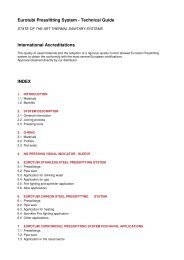Vis PDF - Damstahl
Vis PDF - Damstahl
Vis PDF - Damstahl
Create successful ePaper yourself
Turn your PDF publications into a flip-book with our unique Google optimized e-Paper software.
Technical<br />
information<br />
Chapter 3: Applications of Common Stainless Steel Alloys<br />
Austenitic Stainless Steel:<br />
EN 1.4301 / AISI 304<br />
The classical, stainless steel (18/8) quality and still the most important steel for manufacturing<br />
anything from kitchen sinks, forks and spoons and dairy and butchery equipment. Ductile, weldable<br />
and fairly corrosion resistant in most normal media. However, the resistance in chloride containing<br />
environments (in particular at elevated temperatures) is frequently inadequate. Due to chlorides,<br />
4301 should not be used for outdoors purposes. It is better suited for indoors use. At temperatures<br />
above 60 ºC (and sometimes even below), SCC is a significant risk (Chapter 4). Upgrading to the<br />
even more corrosion resistant 4404 (“acid resistant”) will solve most corrosion problems; otherwise,<br />
even higher alloyed steel types must be considered.<br />
EN 1.4305 / AISI 303<br />
Sulphur alloyed 4301 possessing excellent properties for cutting, milling and so due to the formation<br />
of MnS (Chapter 2). Only available as rod or wire, and is not good for neither welding nor<br />
pickling. Compared to common 4301, the corrosion resistance of 4305 is inferior in almost any type<br />
of media. Consequently, 4305 should be used with care.<br />
EN 1.4306 / AISI 304L<br />
Low-carbon edition of 4301. C ≤ 0,03 % due to the risk of sensitization and subsequent intergranular<br />
corrosion (Chapter 2 + 4). The theoretical disadvantage is a marginally lower mechanical strength.<br />
The nickel content of 4306 is quite high (10-12 %), and the steel is therefore slightly “over-austenitic”<br />
making it less prone to deformation hardening. This, in turn, makes the 4306 useful for stretchforming.<br />
However, the increased nickel makes 4306 quite expensive and hard to get.<br />
EN 1.4307 / AISI 304L<br />
The standard low-carbon 4301. Identical to 4306; however, with less nickel (8-10,5 % Ni). 4307 is<br />
identical with 4301 with the sole exception that the upper limit of carbon is only 0.03 % instead of<br />
0.07 %, which is preferable when welding, in particular when welding thick goods (Chapter 2 + 4).<br />
Due to the lower Ni, 4307 is cheaper and “less austenitic” than 4306 (10-12 %), and traces of ferrite<br />
or deformation martensite may cause some magnetism, in particular after machining.<br />
EN 1.4310 / AISI 301 / 302<br />
”18/8 classic”. An older edition of the standard 4301 recognizable by comparatively high carbon<br />
content. This increases the mechanical strength of the steel. However, the drawback is a significant<br />
increase in the risk of sensitization and intergranular corrosion. Sometimes used when high-temperature<br />
tensile stress is an issue.<br />
EN 1.4401 / AISI 316<br />
The standard ”acid resistant” steel type. Mechanically much like the ”kid brother” 4301; however,<br />
due to its Mo content (2.0-2.5 %), its corrosion resistance is significantly better in almost every<br />
single environment, regardless if the risk of corrosion is pitting, crevice corrosion or SCC (Chapter 4).<br />
Due to the frequently poor performance of 4301, the 4401 ought to replace 4301 as standard material.<br />
However, because of the high and volatile prices of molybdenum and in particular nickel, the<br />
4401 class is often expensive.<br />
289<br />
www.damstahl.com<br />
01.2013
















